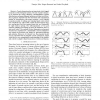Free Online Productivity Tools
i2Speak
i2Symbol
i2OCR
iTex2Img
iWeb2Print
iWeb2Shot
i2Type
iPdf2Split
iPdf2Merge
i2Bopomofo
i2Arabic
i2Style
i2Image
i2PDF
iLatex2Rtf
Sci2ools
ICRA
2007
IEEE
2007
IEEE
Bipedal Walking and Running with Compliant Legs
— Passive dynamics plays an important role in legged locomotion of the biological systems. The use of passive dynamics is expected for energy efficiency, self-stabilization against disturbances, and generating gait patterns and behavioral diversity in general. Inspired from the theoretical and experimental studies in biomechanics, this paper presents a novel bipedal locomotion model of walking and running biped robots which uses compliant legs. This model consists of three-segment legs, two servomoters, and four passive joints that are constrained by eight tension springs. The self-organization of two gait patterns (walking and running) is shown in simulation and in a real-world robot. The analysis of joint kinematics and ground reaction force explains how a minimalistic control architecture can exploit the particular leg design for generating different gait patterns. Moreover, it is shown how the proposed model can be controlled with the simplest control architecture, which would l...
| Added | 03 Jun 2010 |
| Updated | 03 Jun 2010 |
| Type | Conference |
| Year | 2007 |
| Where | ICRA |
| Authors | Fumiya Iida, Juergen Rummel, André Seyfarth |
Comments (0)

